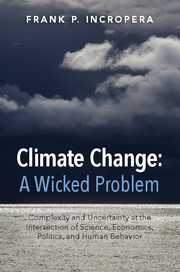 Climate Change: A Wicked Problem
Climate Change: A Wicked Problem Book contents
- Frontmatter
- Dedication
- Contents
- Foreword by Anthony F. Earley Jr.
- Foreword by G.P. “Bud” Peterson
- Foreword by Arun Majumdar
- Preface
- Acknowledgments
- Abbreviations
- 1 Energy, economics, and climate change
- 2 The Earth's climate system
- 3 Greenhouse gases
- 4 Global warming
- 5 Consequences of global warming
- 6 Mitigation, adaptation, and geoengineering
- 7 Public policy options
- 8 The politics of global warming: a history lesson and future prospects
- 9 Dissenting opinions: the great hoax
- 10 The ethics of climate change
- 11 A way forward
- Appendix A Units and conversion factors
- Appendix B Fossil fuels
- Appendix C Anthropogenic sources of natural gas and methane
- Appendix D Environmental time scales and inertia
- Appendix E Coal-fired power plants: operating conditions and costs of carbon capture and sequestration
- Notes
- References
- Index
- Plate section
Appendix D - Environmental time scales and inertia
Published online by Cambridge University Press: 05 October 2015
- Frontmatter
- Dedication
- Contents
- Foreword by Anthony F. Earley Jr.
- Foreword by G.P. “Bud” Peterson
- Foreword by Arun Majumdar
- Preface
- Acknowledgments
- Abbreviations
- 1 Energy, economics, and climate change
- 2 The Earth's climate system
- 3 Greenhouse gases
- 4 Global warming
- 5 Consequences of global warming
- 6 Mitigation, adaptation, and geoengineering
- 7 Public policy options
- 8 The politics of global warming: a history lesson and future prospects
- 9 Dissenting opinions: the great hoax
- 10 The ethics of climate change
- 11 A way forward
- Appendix A Units and conversion factors
- Appendix B Fossil fuels
- Appendix C Anthropogenic sources of natural gas and methane
- Appendix D Environmental time scales and inertia
- Appendix E Coal-fired power plants: operating conditions and costs of carbon capture and sequestration
- Notes
- References
- Index
- Plate section
Summary
Environmental effects can be differentiated in terms of time scales – also called time constants. Pursuant to an input that alters the equilibrium of a system, a time scale provides an approximate measure of how long it takes for the input to achieve a significant portion (e.g., 67%) of its final effect and hence to reach a new equilibrium. The larger the time scale, the larger the inertia of the system.
Consider the infamous fogs that plagued London from the mid-1700s to the mid-1900s. They were not a natural phenomenon, but were anthropogenic and caused by the use of coal for everything from space heating in homes and businesses to, in the twentieth century, generation of electric power. During cold and still winter days, the soot and sulfur-laden gases produced by burning coal would hover over the city, reducing visibility to near zero and inducing serious illness and death among those with respiratory problems. Created by several million sources of coal combustion, the last London fog in 1952 resulted in 4,000 deaths. The problem could no longer be ignored. In 1956, Parliament passed a clean air act prohibiting coal combustion in the homes and businesses of England's largest cities, and the problem, if not eliminated, was significantly alleviated within a few years. This example illustrates an environmental problem for which the causal agents were well understood, the scope was local, there was no uncertainty concerning the nature and seriousness of the consequences, and remedies could be quickly implemented.
The ozone hole in the Earth's stratosphere provides a more recent example, one that's global in scope and for which time scales associated with remediation are much longer. Stratospheric ozone absorbs much of the ultraviolet (UV) components of solar radiation. With depletion of the ozone, more of the UV reaches the Earth's surface, with adverse effects on human health and the environment. The effects could not be ignored, and chemical reactions with the chlorofluorocarbons (CFCs) used in vapor-compression refrigeration and air-conditioning systems were determined to be the culprit.
Recognition of the problem spurred global cooperation in obtaining a solution, highlighted in 1987 by the Montreal Protocol, which committed the world's industrial nations to 50% and 85% reductions in CFC production by 2005 and 2007, respectively.
- Type
- Chapter
- Information
- Climate Change: A Wicked ProblemComplexity and Uncertainty at the Intersection of Science, Economics, Politics, and Human Behavior, pp. 271 - 274Publisher: Cambridge University PressPrint publication year: 2015


